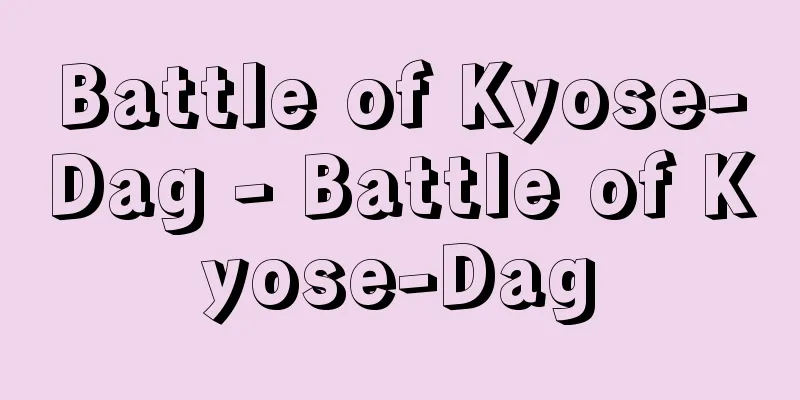Rumor - ryuugen (English spelling) rumor

|
Various rumors spread during major disasters or social unrest. In situations where accurate information is lacking, rumors provide people with erroneous information, creating further confusion, and are therefore often seen as a negative social phenomenon. [Basic formula for rumors] In The Psychology of Rumor (1947), Allport, GW and Postman, L., state that rumors are "propositions about events that are spread among people, usually by mouth to ear, and are believed by people one after another, without any concrete data that can prove their accuracy." The characteristics of rumors are: 1) the information that is spread is information that has not been verified as to whether it is true or not, and as a result it may be either true or false; 2) the information that is spread is believed by the person who spreads it. This means that the person who spreads it is not intentionally spreading a "lie." And 3) it is spread through personal communication. He also formulated the amount of rumour circulation as shown in the figure above. This is well-known as the basic formula for rumors. He stated that the amount of rumour circulation is proportional to the product of the importance of the issue to the parties involved and the vagueness of the evidence. The more important the issue is and the more vague it is, the more likely the rumour will spread. However, if either i or a is zero, the amount of rumour circulation will be zero and the rumour will not spread. Fine, GA and Rosnow, RL (1976) point out that anxiety, along with ambiguity, play an important role in the transmission of rumors. Another factor is the likelihood of the veracity of the content of the communication. However, no strong correlation has been found with the importance of the content of the communication. [The emergence of rumors] Allport et al. consider rumors to be information that is transformed during the process of transmission, and explain the transformation that occurs during the process of transmission in terms of leveling, sharpening, and assimilation, based on a transmission game experiment. Leveling is when the many contents contained in the rumor are reduced to a few elements and changed into a simpler expression. Emphasis is when some of the characteristics of the averaged elements are emphasized in turn. Assimilation is the process in which the meanings of the transformed elements are integrated, and the content is transformed into something that is meaningful as a whole to the transmitter. In contrast, Shibutani, T., in "Rumors and Society: Improvised News" (1966), does not consider rumors to be a transmission process, but rather defines them as "a process in which people who are involved in an ambiguous situation gather their knowledge to make a meaningful interpretation of the situation." In the event of a major disaster, an ambiguous and anxious situation with a lack of information can arise. When there is a lack of information through institutional channels such as mass communication, people will create a new interpretation of the situation based on information from auxiliary channels (interpersonal communication) in order to interpret and redefine the situation they are in. Rumors are said to be the collective occurrence of such a process. Rumors are, in a sense, like news for interpreting a situation. Many researchers now consider the process of rumor generation to be a process in which people in ambiguous and anxious situations jointly interpret the meaning. Knap, R. (1944) analyzed rumors during wartime and classified them into wishful thinking rumors, fear rumors, and schizophrenia rumors based on their emotional elements. Hiroi Osamu (1988) also classified rumors into eruption rumors and pervasive rumors based on the speed of their propagation. The former are rumors that spread in emergency situations such as disasters, and spread rapidly through strangers and converge quickly. The latter are rumors that spread during normal times, and spread slowly over time in everyday communication networks and converge slowly. [Rumors and gossip] Kawakami Yoshiro (1997) classified rumors in everyday language into rumors, urban legends, and gossip. Urban legends are gossiping stories such as "The Slit-Mouth Woman," which have a narrative quality, are repeated, and are judged not on whether they are true or not, but on whether they are plausible. While rumors are an instrumental form of communication that transmits information, urban legends have the nature of self-contained communication that aims for the act of speaking itself. Gossip is gossip about people close to us. The main difference between gossip and rumors is that rumors mainly convey social information, whereas gossip conveys personal information. It is also known that gossip fulfills social psychological functions such as social boundary setting, formation of social norms, and social comparison in small groups (Suls, J., 1977). In Japanese, rumor is used as a general term for these. [Related terms] A term similar to rumors is demagoguery. It refers to something that is spread intentionally for a certain political purpose, while knowing that it is not true. Rumors are things that are thought to be true and spread spontaneously, while hoaxes are things that are spread intentionally and then spread like rumors. In general, whether rumors or hoaxes, they will not spread even if they are spread with the intention of spreading. They will not spread unless the individual who received the rumor tells others about it. Recently, the term "rumor damage" has come to be used when economic damage occurs in a specific region or organization as a result of people refraining from purchasing certain products or canceling trips based on reports of disasters or accidents. It is a phenomenon caused by the widespread occurrence of actions to avoid dangers that are imagined from mass media reports, regardless of actual danger. Unlike rumors, it does not occur as a result of interactions between individuals, but is the result of the same actions occurring as a result of mass media reports. Word of mouth, which is an individual's evaluation of a product or service, has also become very influential due to the Internet. The spread of the Internet and mobile phones has expanded the scope of personal communication to an unprecedented extent. As a result, rumors have spread at a much faster rate and to a greater extent. In the Internet society, personal communication, including rumors, has come to have a greater influence than ever before. → Disaster Psychology [Yoshiro Kawakami] Latest Sources Psychology Encyclopedia Latest Psychology Encyclopedia About Information |
|
大きな災害時や社会の混乱時には多様な流言が流れる。流言は正確な情報が欠落した状況下では,人びとに誤った情報を与え,いっそうの混乱を生み出すものとして,ネガティブな社会現象としてとらえられることが多い。 【流言の基本公式】 オルポートAllport,G.W.とポストマンPostman,L.は,『デマの心理学The Psychology of Rumor』(1947)において,流言を「正確さを証明することのできる具体的なデータがないのに,ふつう,口から耳へと伝えられて,次々に人びとの間に言いふらされ,信じられてゆく,出来事に関する命題」であると述べている。流言の特質として,①伝えられる内容が真実かどうか検証されていない情報であり,結果として正しいことも誤りであることもある点。②伝えられる内容は伝達者にとって信じられているものである点。このことは,伝達者は意図的に「うそ」を伝えているのではないということである。そして③パーソナル・コミュニケーションによって伝えられるものとした。 また,流言の流布量を上の図のように定式化した。これは流言の基本公式として有名である。流言の流布量は,当事者にとっての問題の重要さと証拠の曖昧さの積に比例するとした。問題が重要であればあるほど,また曖昧であればあるほど,流言は広がりやすくなるのである。しかし,iかaのいずれかがゼロであれば,流言の流布量はゼロとなり流言は広がらないとした。ファインFine,G.A.とロスノウRosnow,R.L.(1976)は,流言の伝達に,曖昧さとともに不安が重要な役割を果たすことを指摘している。このほかにも,伝達内容の真実らしさが挙げられる。なお伝達内容の重要性については強い関連は見いだされていない。 【流言の発生】 オルポートらは,流言を情報が伝達される過程で変容したものと考え,伝達ゲームの実験から,伝達の過程で起こる変容を平均化leveling,強調化sharpening,同化assimilationで説明する。平均化とは,流言に含まれる多数の内容が,少数の要素に減少し,より平易な表現に変化すること。強調化は,平均化した要素が今度は逆にその中の一部の特徴が強調されること。そして,同化は,変容した要素間で意味の統合が起こる過程であり,伝達者にとって全体として意味のある内容に変容するとした。これに対してシブタニShibutani,T.は,『流言と社会Improvised News』(1966)において,流言を伝達のプロセスととらえるのではなく,「曖昧な状況にともに巻き込まれた人びとが,自分たちの知識を寄せ集めることによって,その状況について有意味な解釈を行なうプロセス」と定義した。大きな災害時などには,情報の不足した,曖昧で不安な状況が生まれる。その中で,マスコミュニケーションなど制度的チャンネルを通した情報に欠落があると,人びとはおかれている状況を解釈し再定義するために,補助的チャンネル(対人コミュニケーション)からの情報を基に新たな状況の解釈を作り上げていく。そのようなプロセスが集合的に発生したものが流言であるとした。流言はいわば状況解釈のためのニュースといった性質をもつとしたのである。現在では,流言の発生過程を曖昧で不安な状況におかれた人びとが共同して意味解釈する過程と考える研究者が多い。流言の分類として,ナップKnap,R.(1944)は,戦時下における流言を分析し,感情的な要素から,願望流言,恐怖流言,分裂流言に分類した。また,廣井脩(1988)は,流言の伝播速度から,噴出流言と浸透流言に分類した。前者は災害時など緊急事態に流れる流言であり,見知らぬ人を通して急速に広がり,収束するのも速い。後者は平常時の流言であり,日常的なコミュニケーションネットワークの中で時間をかけてゆっくりと流れ,収束するのは遅い。 【うわさと流言】 川上善郎(1997)は,日常語としてのうわさを,流言,都市伝説,ゴシップに分類した。都市伝説urban legendは,「口裂け女」などのうわさ話であり,ストーリー性をもち,繰り返し話され,事実かどうかよりは,ありそうな話かどうかで判断されるものである。流言が情報伝達という道具的コミュニケーションinstrumental communicationであるのに対し,話すこと自体を目的とする自己完結的コミュニケーションという性質をもつ。ゴシップgossipは,身近な人に関するうわさ話である。流言との違いは,流言が主に社会情報を伝えるのに対して,個人的な情報を伝えるという点で大きく異なる。また,ゴシップは,小集団において社会的な境界づけ,社会規範の形成,社会的比較などの社会心理学的機能を果たすことが知られている(Suls,J.,1977)。日本語では,うわさがこれらの総称として使われている。 【関連する用語】 流言と類似した用語にデマゴギーDemagogie(デマ)がある。真実でないことを知りつつ,一定の政治的目的のために意図的に流されたものを指す。流言は真実と考えられたものが自然発生的に流れるのに対して,デマは意図的に流された後,流言のように広がったものである。一般に流言にしろ,デマにしろ,広めることを意図して流しても基本的に広がることはない。流言を受け取った個人が他人に伝えない限り広がることはない。最近では,災害や事故の報道から判断して,特定の商品を買い控えたり,旅行を取りやめたりすることで特定の地域や団体に経済的な損害が発生した場合に風評被害ということばが使われるようになった。実際の危険とは関係なく,マスコミ報道から想起される危険を回避するための行動が広範囲に発生することで,引き起こされる現象である。流言のように個人間の相互作用の結果として生ずるものではなく,マスコミ報道の結果,同一の行動が生起する結果である。また,商品やサービスについての個人の評価である口コミword of mouthもインターネットによって大きな影響力をもつようになっている。 インターネットと携帯電話の普及は,パーソナル・コミュニケーションの範囲をこれまでになく拡大した。その結果,流言の広がる速度,範囲を一段と高めることになった。インターネット社会においては,流言も含めて,パーソナル・コミュニケーションが,これまでになく大きな影響力をもつに至っている。 →災害心理学 〔川上 善郎〕 出典 最新 心理学事典最新 心理学事典について 情報 |
<<: Liu Xuan (English spelling)
Recommend
Wenseki - Wenseki
...Boundary marking devices similar to shimenawa ...
Sensory skin
…The cutaneous ridges maintain a moderate degree ...
Mahabalipuram - Mahabalipuram (English spelling)
A representative Hindu ruin of the Pallava dynast...
Button fern
...The sporophylls are rather large and tall, wit...
Xiao Army
Chinese author. His real name was Liu Honglin. Xi...
Rizalista
…This is the Iglesia ni Cristo church. Another no...
Inagaki Castle - Inagaki Castle
…During the formation of the state, mountain fort...
Sheet metal press forming - Bankin Press Kako (English)
A processing method in which a press is used to di...
Vedda; Wedda
A minority tribe that lives in the forests of east...
Maria Cristina de Borbón
1806‐78 Queen of Spain, Ferdinand VII. Daughter of...
castella
…The area stretches from the Bay of Biscay in the...
Ukimono Aya
… The changes in the production system and the ri...
Cognitive engineering
An engineering technology that uses the results of...
Phaidra
…In Greek legend, the son of Athenian king Theseu...
Heita Okabe
1891-1966 A physical education instructor from th...








![Seki [town] - Seki](/upload/images/67cc022c43895.webp)
